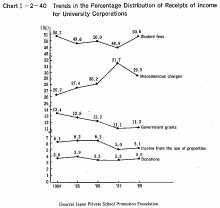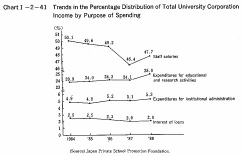| Home > Policy > White Paper, Notice, Announcement > White Paper > JAPAMESE GOVERNMENT POLICIES IN EDUCATION,SCIENCE AND CULTURE 1990 > PART |
||
In analyzing the financial conditions of "school corporations" managing private educational institutions, attention needs to be paid to the fact that these corporations have a basic nature which is different from profit-raising corporations.
In general, as a profit-raising corporation is basically aimed at making profits, the more it raises profits, the quicker it grows as a corporation, and the better it is evaluated as a good corporation with a sound managerial and financial basis. On the other hand, an educational institution is a public and permanent entity aimed at educational and research activities. It would not be valid to evaluate the effectiveness of its finances in terms of the size of the surplus of income. It is essential to analyze its financial status in terms of whether the sound financing of the educational institute is likely to be maintained in a long perspective, whether the financial burdens of students are appropriate, and whether the staffing, physical and other resources are being adequately provided for educational and research programs.
(2) Income and expenditures for recurrent funds According to a 1988 survey of the income and expenditures for
current funds for school corporations maintaining private institutions of higher
education, the total income (excluding loans) of all corporations maintaining
universities (hereinafter referred to as "university corporations") was 3,175,700
million yen (for 335 corporations) and that of corporations maintaining junior
colleges (hereinafter referred to as "junior college corporations") was 530,600
million yen (for 257 corporations).The total amount of student fees representing
the largest proportion of all receipts of income was 1,606,400 million yen for
all university corporations and 303,600 million yen for all junior college corporations.
The total sum of government grants was 359,100 million yen for all university
corporations and 88,100 million yen for all junior college corporations. (For
university or junior college corporations which also maintain elementary or secondary
schools, student fees and government grants include those for these schools.)
For university corporations, the proportion of student fees has been slightly
increasing and that of government grants gradually decreasing. (See Chart ![]() -2-40.)
-2-40.)

The total amount of current income (i.e., the amount of total income other than loans minus a transfer to endowment funds) in fiscal 1988 was 2,578,500 million yen for all university corporations and 393,500 million yen for all junior college corporations.
On the other hand, the total amount of current expenditures
in 1988 was 2,554,200 million yen for all university corporations and 346,300
million yen for all junior college corporations. The largest proportion of total
income (excluding loans) of higher education corporations is devoted to staff
salaries. The past trend in the percentage distribution of current expenditures
for university corporations categorized by purpose shows that the proportion
of salaries has been gradually decreasing, and that of expenditures for educational
and research programs and for institutional administration has been gradually
increasing. This trend indicates that university corporations have been striving
to improve the educational and research activities of the universities they maintain.
(See Chart ![]() -2-41.)
-2-41.)

According to the statements of assets and liabilities by university and junior college corporations as of the end of fiscal 1988, the total amount of assets was 9,667,000 million yen for all university corporations and 1,765,700 million yen for all junior college corporations. The total amount of liabilities was 2,635,900 million yen for university corporations and 451,800 million yen for junior college corporations. The total amount of endowments was 7,289,300 million yen for university corporations and 1,180,200 million yen for junior college corporations. Regarding the accumulated balance between current income and expenditure, there was 258,100 million yen excess of expenditure over income for university corporations and 133,700 million yen surplus of income for junior college corporations. The proportion of total liabilities to total assets was 27.3% for university corporations and 25.6% for junior college corporations. It can be stated that financial conditions have been improving both for university corporations and for junior college corporations.
(4) Efforts to stabilize financial management of university or junior college corporationsThe financial conditions of school corporations in general have been improving year by year. However, many university corporations are confronted with the problem of accumulated deficit, and the total sum of long-term loans amounts to 811,000 million yen for university corporations and 205,300 million yen for junior college corporations. Considering this fact, individual corporations need to make further efforts to stabilize their financial management through, for example, Raising more donations positively and making the efficient use of their properties. The method of using their properties should be determined by individual corporations themselves on their own responsibility. However, since these properties are important assets supporting the educational and research activities of educational institutions, it is hoped that individual corporations cautiously carry out the utilization of these assets, paying special attention to ensuring the safety of the assets.
If individual corporations are to ensure their own sound financial management, it is very important to obtain an understanding of their financial conditions among as many people as possible. Every corporation maintaining educational institutions is required by law to keep relevant financial documents, including a statement of assets and liabilities and a statement of receipts of income and expenditures. It is hoped that, whenever necessary, individual corporations make clear their real financial state to the people concerned.
| Back to Top | MEXT HOME |